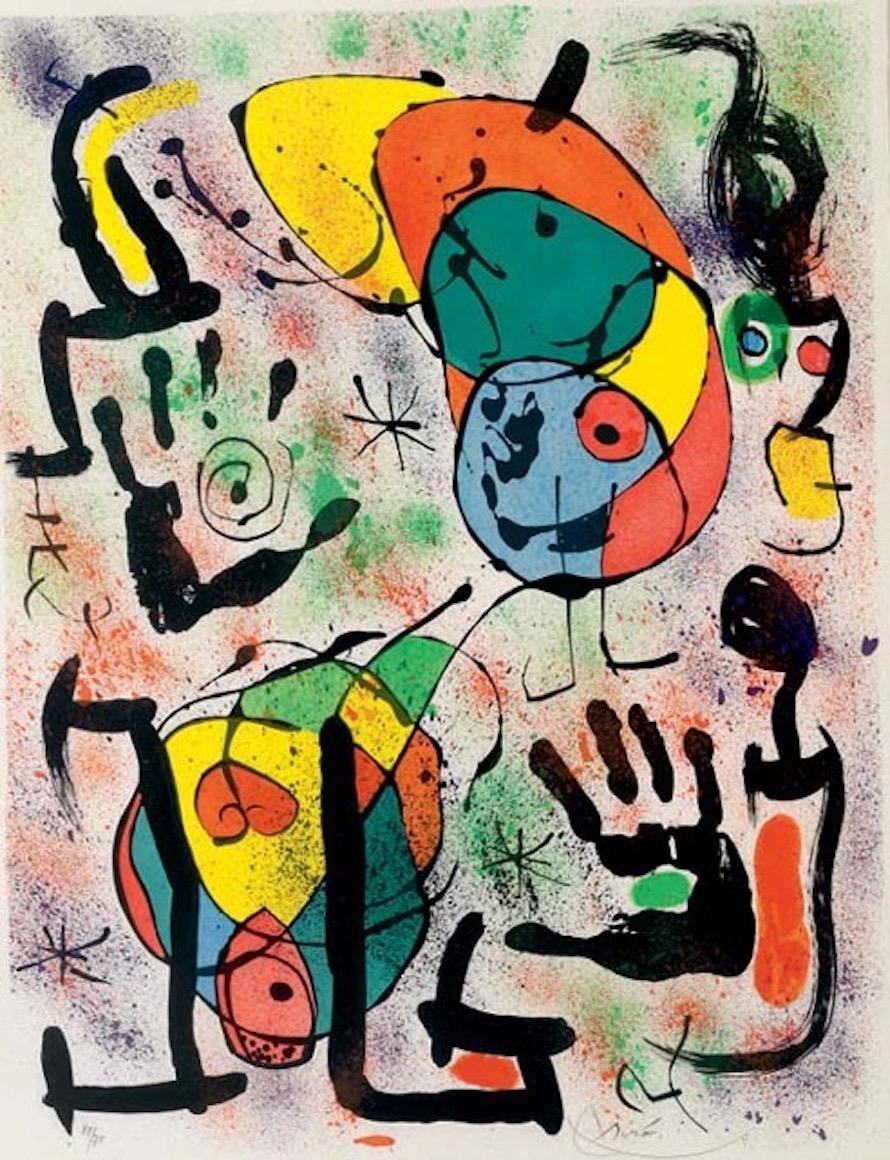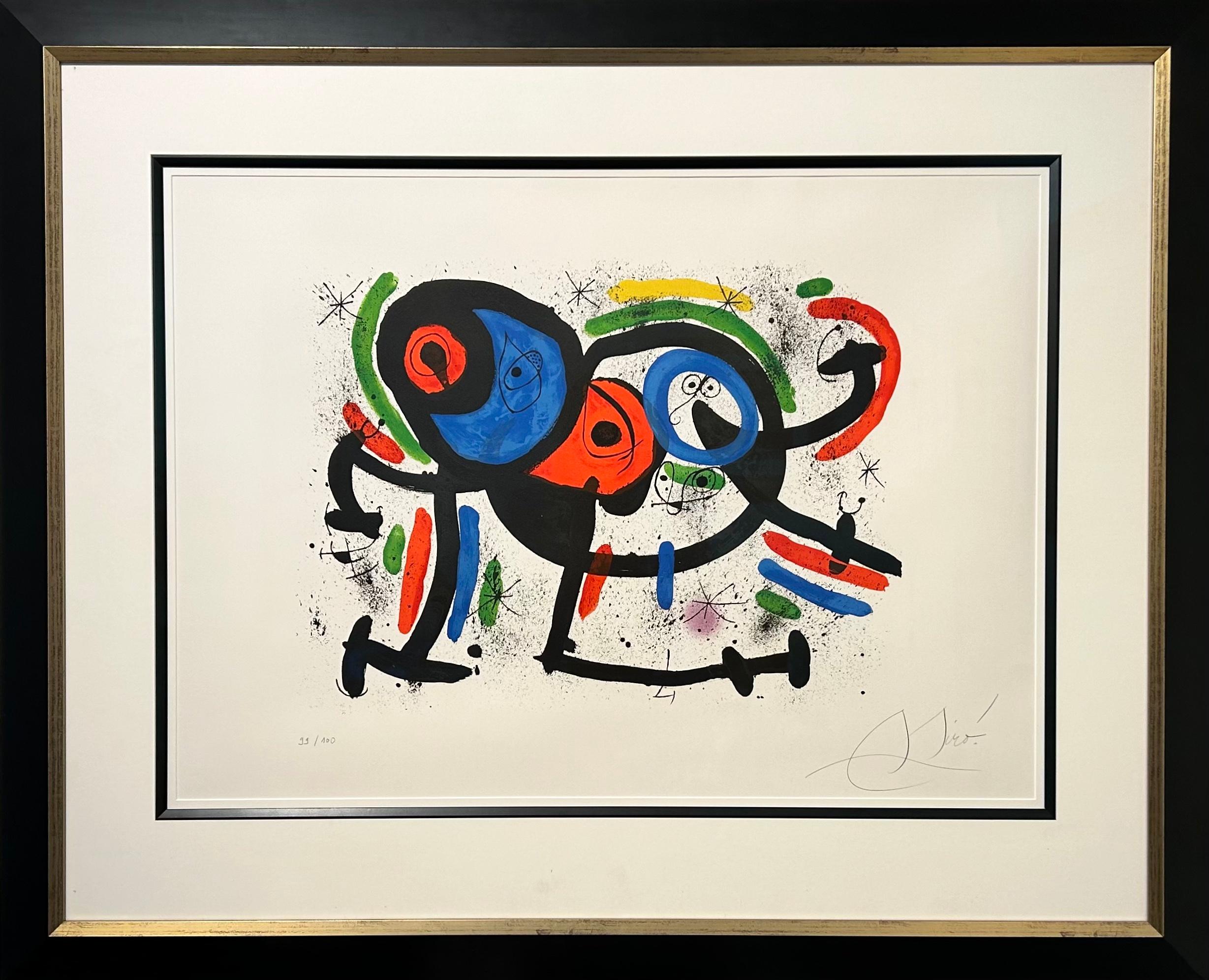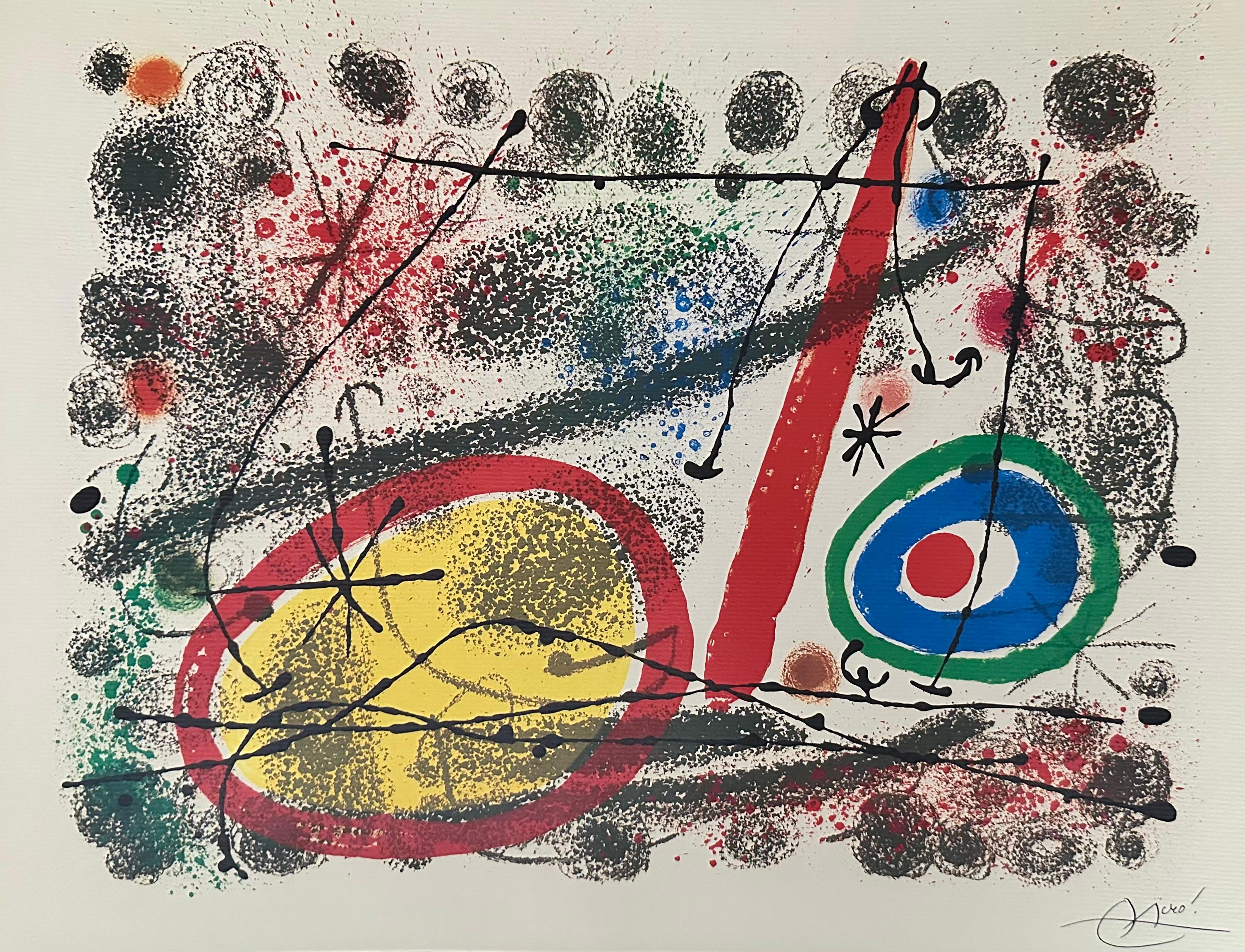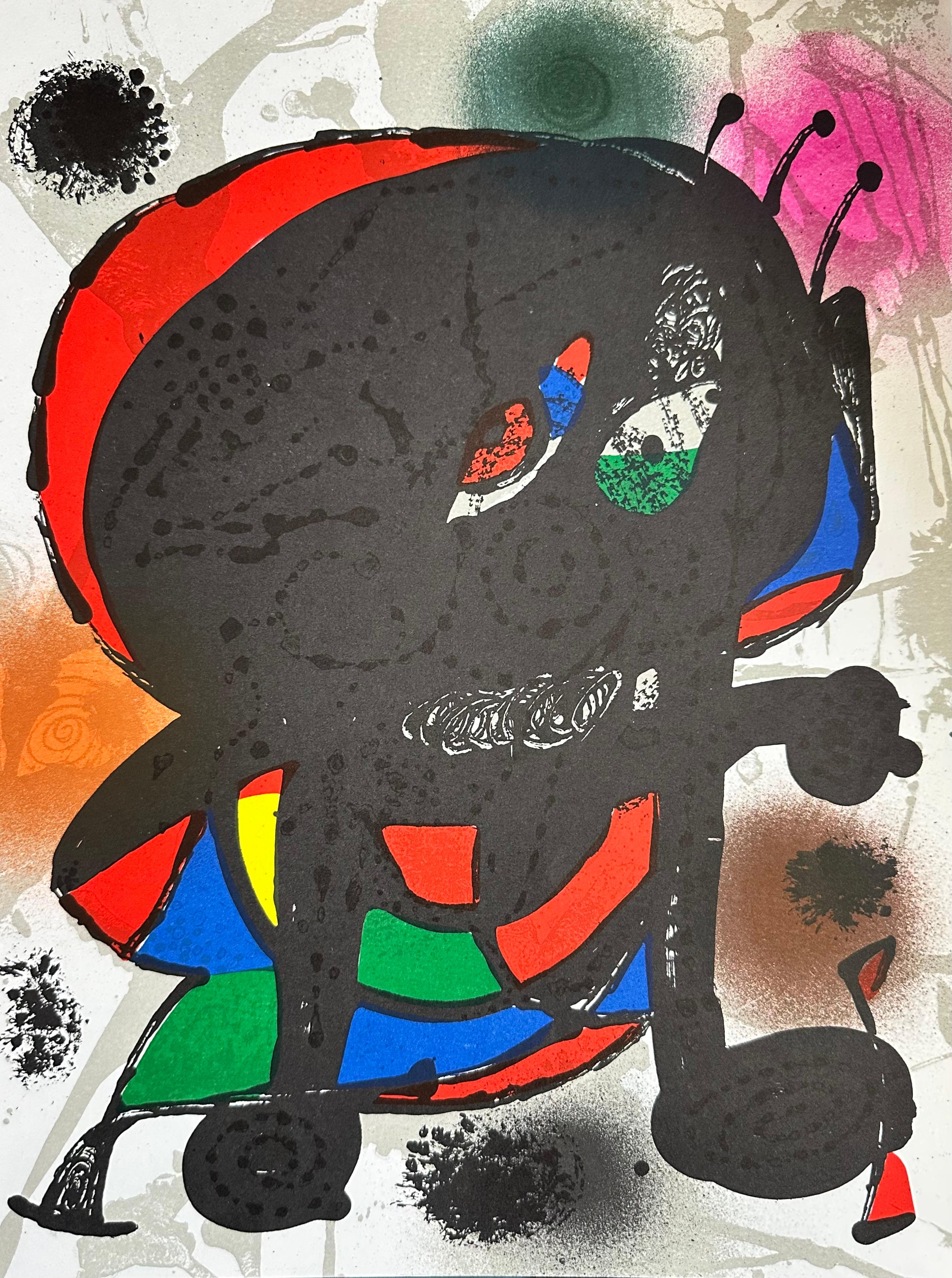Want more images or videos?
Request additional images or videos from the seller
1 of 5
Wifredo LamDouble Personage1979
1979
About the Item
Double Personage
Color lithograph, 1975 (?)
Unsigned (as issued)
Edition: Large Edition Limited, (estimated to be approximately 2000)
Published in: XXe Siecle, No. 52, Juin 1979
Published: G. di San Lazzaro
Printer: Mourlot Imprimeur, Paris, France
Reference: Lam-Tonneau-Ryckelynck L7513
Condition: Excellent, fresh colors
Traces of glue residue along margin edge where it was bound in the book
Image/sheet size: 12 1/4 x 9 1/4 inches
Wilfredo Lam (1902-1982)
Biography
Wifredo Lam was born in Sagua la Grande, Cuba, on December 8, 1902. He was the eighth child born to Lam-Yam―born in Canton around 1820, an immigrant to the Americas in 1860―and to Ana Serafina Catilla―born in 1862 in Cuba of mixed African and Spanish ancestry.
The luxuriant nature of Sagua la Grande had a strong impact on Lam from early childhood. One night in 1907, he was startled by the strange shadows cast on the wall of his bedroom of a bat in flight. He often recounted the incident as his first magnificent awakening to another dimension to existence.
In 1916, Lam and part of his family settled in Havana. He was enrolled in the Escuela Profesional de Pintura y Escultura, Academia de San Alejandro, where he remained a student until 1923. This period, with exhibitions at the Salón de Bellas artes, was determinant in his choice to become a painter. In 1923, the municipality of Sagua la Grande awarded him a grant to study in Europe and by the autumn of that year, at the age of twenty-one, he left the country for Spain.
His time in Spain―initially intended as a short stay on his way to Paris―lasted 14 years. In Madrid, he was exposed to the ideas and movements of modern art. He spent long hours at the Archeological Museum and the Prado. He studied the great masters of Spanish painting, Velázquez and Goya, but felt particularly drawn to the works of Bosch and Bruegel the Elder. He discovered surprising correlations between western art and so called “primitive” art. In 1931, his first wife, Eva (Sébastiana Piriz) and their son Wilfredo Victor died of tuberculosis. The terrible suffering he endured led to numerous paintings of mother and child. Lam found solace in the company of his Spanish friends and made contact with several political organizations. In 1936, with the help of his friend Faustino Cordón, he joined the Republican forces in their fight against Franco. He designed anti-Fascist posters and took part in the struggle by working in a munitions factory. The violence of the struggle inspired his painting La Guerra Civil.
In 1938, Lam left Spain for Paris. Shortly before leaving, he met Helena Holzer, who would become his wife in 1944. His meeting Picasso in his studio on the Rue des Grands Augustins proved decisive. Picasso introduced his new “cousin” to his painter, poet and art critic friends, Braque, Matisse, Miró, Léger, Eluard, Leiris, Tzara, Kahnweiler, Zervos. Lam also met Pierre Loeb, the owner of the Galerie Pierre in Paris, which hosted Lam’s first solo exhibition in 1939.
Shortly before the Germans arrived, Lam left Paris for Bordeaux and then Marseille, where many of his friends, for the most part surrealists, had gathered around André Breton in the Villa Air Bel: Pierre Mabille, René Char, Max Ernst, Victor Brauner, Oscar Domínguez, André Masson, Benjamin Péret. In the Villa Air Bel, a meeting place for creativity and experimentation, Lam worked and produced, most notably, a series of ink drawings that set the tone for what would become his signature style of hybrid figures, a vocabulary he would develop more fully during his years in Cuba from 1941 to 1947.
In January and February 1941, Lam illustrated Breton’s poem Fata Morgana which was censored by the Vichy government. On March 25, Lam and Helena Holzer embarked on the “Capitaine Paul Lemerle” headed for Martinique, in the company of some 300 other artists and intellectuals―André Breton and Claude Lévi-Strauss among them. Upon arrival, the passengers were interred at Trois Îles. It was during this forced passage in Martinique and before leaving for Cuba that Lam and Aimé Césaire met for the first time to become life-long friends.
Newly settled in his native land after almost twenty years, Lam delved deeper into his artistic investigations, finding nourishment for his ideas in the surroundings of his childhood and youth. His sister Eloisa, whom he was closest to, explained to him in much detail the workings of Afro-Cuban rituals and he began attending ritual ceremonies with some of his friends. This contact with Afro-Cuban culture brought new impetus to his art. He painted over one hundred canvases, most notably La Jungla, making the year 1942 his most productive of this period. Over the next few years, a number of exhibitions followed in the United States, at the Institute of Modern Art of Boston, at the MoMA of New York, at the Galerie Pierre Matisse, where La Jungla was presented and created a scandal.
In 1946, Lam and Helena travel to Haiti and attend voodoo ceremonies in the company of Pierre Mabille and André Breton. Talking about his experience in Haiti, Lam said, “It is often assumed that my work took its final form in Haiti, but my stay there, like the trips I made to Venezuela, Colombia or to the Brazilian Mato Grosso only broadened its scope. I could have been a good painter from the School of Paris, but I felt like a snail out of its shell. What really broadened my painting is the presence of African poetry.”
Picasso_Lam_Vallauris_1954_vignette
Wifredo Lam et Pablo Picasso, Vallauris, 1954
Lam then went on to New York where he renewed contact with Marcel Duchamp and made new acquaintances: Jeanne Reynal, James Johnson Sweeney, Arshile Gorky, John Cage, Roger Wilcox, Mercedes Matter, Ian Hugo, Jesse Fernández, John Cage, Sonia Sekula and Yves Tanguy. By the end of the 1940s, Lam divided his time between Europe, Havana and New York, where they stayed with Pierre and Teeny Matisse as well as Jeanne Reynal. He enjoyed the company of numerous artists: Noguchi, Hare, Motherwell, Pollock, Asger Jorn and the dissident surrealist group CoBrA.
From 1947, Lam’s style began to show new developments: a pronounced presence of esoteric elements and a coupling of the influence of Oceanic art with that of African art. His reputation as an artist had spread internationally. Articles on Lam appeared in prestigious publications and reviews around the world such as VVV, Instead, ArtNews and View, and exhibitions of his work in the United States, Haiti, Cuba, France, Sweden, England, Mexico, Moscow and Prague.
After his divorce with Helena Holzer, in 1952 Lam settled in Paris. In 1955, he met the Swedish artist Lou Laurin―the couple would marry in 1960. He wins the Grand Prix of the Havana Salon and, in 1958, is named a member of the « Graham Foundation for Advanced Study in Fine Art » in Chicago and received numerous awards, most notably the « Guggenheim International Award » in 1964.
Throughout the 1950s, while maintaining close contact with Cuban art circles, Lam became increasingly involved with European artistic currents, developing close ties with CoBrA artists and the Italian avant-garde. He also joined post-war movements such as “Phases” and the Situationist movement.
In 1954, Lam met the poets Gherasim Luca and Alain Jouffroy. He traveled to Italy, to Albissola, on the initiative of Asger Jorn and Édouard Jaguer who had organized an international meeting of sculpture and ceramics which included as participants: Appel, Baj, Corneille, Dangelo, Fontana, Scanavino and Matta. Encouraged by the art dealer, Carlo Cardazzo, they would transform this little Italian village on the Ligurian coast into a gathering point for artistic experimentation, from the late fifties through to the late sixties.
During the 1960s, Lam’s work reflected a growing interest for engraving. Collaborating with poets and writers, he undertook several important projects in printmaking: large format portfolios, pulled and published in the print studios of Broder, Mathieu and Upiglio, most notably: La terre inquiète by Édouard Glissant (1955), Le voyage de l’arbre by Hubert Juin (1960), Le rempart de brindilles by René Char (1963), Apostroph’Apocalypse by Gherasim Luca (1965), L’Antichambre de la Nature by Alain Jouffroy (1966), Annonciation by Aimé Césaire (1969). His meeting with the master engraver Giorgio Upiglio at his studio Grafica Uno in Milan inaugurated a period of intense creativity that would last all the way up to Lam’s death in 1982.
From 1964, Lam divided his time between Paris and Albissola Mare, in Italy, where he set up a painting studio in his new house. He close friends with many writers and artists, and his work would be celebrated in many exhibitions and retrospectives around the world.
Jean-Louis Paudrat
- Creator:Wifredo Lam (1902-1982, Cuban)
- Creation Year:1979
- Dimensions:Height: 12.25 in (31.12 cm)Width: 9.25 in (23.5 cm)
- Medium:
- Movement & Style:
- Period:
- Condition:
- Gallery Location:Fairlawn, OH
- Reference Number:
About the Seller
5.0
Recognized Seller
These prestigious sellers are industry leaders and represent the highest echelon for item quality and design.
Platinum Seller
These expertly vetted sellers are 1stDibs' most experienced sellers and are rated highest by our customers.
Established in 1978
1stDibs seller since 2013
711 sales on 1stDibs
Typical response time: 1 hour
Associations
International Fine Print Dealers Association
- ShippingRetrieving quote...Ships From: Fairlawn, OH
- Return PolicyA return for this item may be initiated within 10 days of delivery.
More From This SellerView All
- El Ultimo viaje del buque fantasma, Plate IBy Wifredo LamLocated in Fairlawn, OHEl Ultimo viaje del buque fantasma, Plate I Color lithograph, 1976 Signed and numbered in pencil (see photos) Edition: 99 (6/99) From: Gabriel Garcia Marquez, El Ultimo viaie del buque Fantasma (The Last Voyage of the Ghost Ship (1868), 12 illustration by Wilfredo Lam This one of an edition of 99 from the delixe edition of the book of the same title There was an additional edition of 200 books, signed and numbered on the justification page Publisher: Poligrafa, Barcelona Printer: Poligrafa, Barcelona The Gabriel Garcia Marquez/Lam book is an illustrated version of the short story, a man recalls the night during his boyhood when an enormous passenger ship went aground in his small town on the shores of the Caribbean. It is considered a Latin American masterpiece of surrealism and transculturation. (See below analysis of the story) Reference: Lam-Tonneau-Ryckelnck CR 351 Condition: very good, slight scuffing on reverse from previous hinges About the author and the storyline of the book by Marquez: Gabriel García Márquez was born in 1927, he is a famous Colombian writer, novelist, short story writer, screenwriter and journalist. In 1982 he received the Novel Prize for Literature. He is an author sometimes inherently related to magical realism and his best-known work is the novel One Hundred Years of Solitude in which we find this literary genre. Summary of "The Last Voyage of the Ghost Ship" (1868): The novel by Gabriel García Márquez, The Last Voyage of the Ghost Ship, written in 1968, is written in a single great sentence, which tells the surprising and amazing adventure that has changed the existence of a child living in a coastal town with a small port sunny, almost forgotten by civilization. The days are peaceful, the nights are silent and illuminated only by the rotating beacon that, every fifteen seconds, transforms the town into a lunar camp with phosphorescent houses. During one night in March, the boy saw an immense afterlife ship that sails through the seas with all the dead crew and sometimes appears to the living, silently crossing the deserted sea, a huge and unexpected mass whose trajectory suddenly it seems to drift, and then runs aground on the reefs. This cataclysm is accomplished without disturbing the night's silence, and the next day the boy found no traces of the shipwreck and no one believed it, not even his mother. Time passes, and the same shipwreck occurs again, every year, on the same night in March; the adolescent...Category
1970s Surrealist Abstract Prints
MaterialsLithograph
- El Ultimo viaje del buque fantasma, Plate IVBy Wifredo LamLocated in Fairlawn, OHEl Ultimo viaje del buque fantasma, Plate IV Color lithograph, 1976 Signed and numbered in pencil (see photos) From: Gabriel Garcia Marquez, El Ultimo viaie del buque Fantasma (The Last Voyage of the Ghost Ship (1868), 12 illustration by Wilfredo Lam Edition: 99 (6/99) This one of an edition of 99 from the deluxe edition of the book of the same title There was an additional edition of 200 books, signed and numbered on the justification page Publisher: Poligrafa, Barcelona Printer: Poligrafa, Barcelona The Gabriel Garcia Marquez/Lam book is an illustrated version of the short story, a man recalls the night during his boyhood when an enormous passenger ship went aground in his small town on the shores of the Caribbean. It is considered a Latin American masterpiece of surrealism and transculturation. (See below analysis of the story) Condition: slight yellows (aging) of paper small paper scuffs verso from previous hinges Sheet size: 22 x 29 7/8 inches About the author and the storyline of the book by Marquez: Gabriel García Márquez was born in 1927, he is a famous Colombian writer, novelist, short story writer, screenwriter and journalist. In 1982 he received the Novel Prize for Literature. He is an author sometimes inherently related to magical realism and his best-known work is the novel One Hundred Years of Solitude in which we find this literary genre. Summary of "The Last Voyage of the Ghost Ship" (1868): The novel by Gabriel García Márquez, The Last Voyage of the Ghost Ship, written in 1968, is written in a single great sentence, which tells the surprising and amazing adventure that has changed the existence of a child living in a coastal town with a small port sunny, almost forgotten by civilization. The days are peaceful, the nights are silent and illuminated only by the rotating beacon that, every fifteen seconds, transforms the town into a lunar camp with phosphorescent houses. During one night in March, the boy saw an immense afterlife ship that sails through the seas with all the dead crew and sometimes appears to the living, silently crossing the deserted sea, a huge and unexpected mass whose trajectory suddenly it seems to drift, and then runs aground on the reefs. This cataclysm is accomplished without disturbing the night's silence, and the next day the boy found no traces of the shipwreck and no one believed it, not even his mother. Time passes, and the same shipwreck occurs again, every year, on the same night in March; the adolescent...Category
1970s Surrealist Abstract Prints
MaterialsLithograph
- El Ultimo viaje del buque fantasma, Plate IIIBy Wifredo LamLocated in Fairlawn, OHEl Ultimo viaje del buque fantasma, Plate III Color lithograph, 1976 Signed and numbered in pencil From: Gabriel Garcia Marquez, El Ultimo viaie del buq...Category
1970s Surrealist Abstract Prints
MaterialsLithograph
- El Ultimo viaje del buque fantasma, Plate XBy Wifredo LamLocated in Fairlawn, OHEl Ultimo viaje del buque fantasma, Plate X Color lithograph, 1976 Signed in pencil lower right corner (see photo) From: Gabriel Garcia Marquez, El Ultimo viaie del buque Fantasma (The Last Voyage of the Ghost Ship (1868), 12 illustration by Wilfredo Lam Edition: 99 (6/99) This one of an edition of 99 from the delixe edition of the book of the same title There was an additional edition of 200 books, signed and numbered on the justification page Publisher: Poligrafa, Barcelona Printer: Poligrafa, Barcelona The Gabriel Garcia Marquez/Lam book is an illustrated version of the short story, a man recalls the night during his boyhood when an enormous passenger ship went aground in his small town on the shores of the Caribbean. It is considered a Latin American masterpiece of surrealism and transculturation. (See below analysis of the story) Sheet size: 29 7/8 x 22 inches Condition: Very fresh colors and condition Slight scuffing verso from previous hinges Reference: Lam-Tonneau-Ryckelnck CR360 About the author and the storyline of the book by Marquez: Gabriel García Márquez was born in 1927, he is a famous Colombian writer, novelist, short story writer, screenwriter and journalist. In 1982 he received the Novel Prize for Literature. He is an author sometimes inherently related to magical realism and his best-known work is the novel One Hundred Years of Solitude...Category
1970s Surrealist Abstract Prints
MaterialsLithograph
- Les Bijoux IndiscretsBy René MagritteLocated in Fairlawn, OHLes Bijoux Indiscrets (The Indiscreet Jewels) Color lithograph, 1962-3 As published in XXeme Siecle, 1963 From the edition issued by San Lazarro unsigned for the album XXeme Siècle No.22. Printed from the same stones and at the same date as the signed edition of 75 impressions. Printed at the studio of Mourlot, Paris 1963. Signed in the stone (see photo) Titled in the stone (See photo) Edition c. 2000 Reference: Kaplan and Baum: Magritte Graphic Work no 3. Kaplan, Surrealist Prints, Figure 80, page 103 Image size: 9 3/16 x 11 7/8 inches "Executed in 1963, Les bijoux indiscrets (pen and ink drawing) is a work which shows a hand which has a face, its eyes closed, on its wrist. Magritte had originally intended to call the oil version of this work, which he conceived of in 1962 but only finally painted during the following year, the same this work on paper was created, La divine comédie, but according to the catalogue raisonné changed his mind following the suggestion of his friend Paul Scutenaire. Instead of the Dante reference, it was replaced by one to Denis Diderot's first novel, a satire in which a monarch had a magic ring able to make the genitals of women speak. In an old English translation, the bijoux were the 'toys', or genitals, of the women, making the play on the notion of transformative and elusive jewels evoked by Magritte's picture all the more complex. For here, in place of a bracelet, is a human face: this is, indeed, an indiscreet jewel; however, in the eighteenth-century novel the indiscretion was shared by the ring which was able to gain such voluble responses from the women of the fictitious Congo of which the main protagonist was sultan and by those women's no-longer-private parts themselves. This title therefore adds an extra layer of Surrealism to the work, paying homage to one of the movement's predecessors. Les bijoux indiscrets is a preparatory work for a lithograph that Magritte created for XXe Siècle, which was published at Christmas the same year. Clearly, the artist was returning to and embellishing his original composition, which had shown a simple landscape as a backdrop to the articulate hand...Category
1960s Surrealist Prints and Multiples
MaterialsLithograph
- Cahiers d'art, Surrealist Composition 1By Joan MiróLocated in Fairlawn, OHCahiers d'art, Surrealist Composition 1 Pochoir, 1934 Unsigned as issued in Cahier's edition Published in Cahier's d'art, 1934 Unsigned Edition of 1200 There was also a pencil signed...Category
1930s Surrealist Abstract Prints
MaterialsStencil
You May Also Like
- The SeersBy Joan MiróLocated in New York, NYThe Seers Plate 6 1970 Hand-Signed Lithograph in colors 25 1/4 x 19 1/2 in Edition 75Category
1970s Surrealist Abstract Prints
MaterialsLithograph
- Colour Lithograph 'La Triple Roue ll' 1981By Joan MiróLocated in Toronto, CA'La Triple Roue ll' Limited edition colour lithograph on Arches paper from Joan Míro's final series of fifteen lithographs, 'Allegro Vivace' 1981. The series is known for its bold fo...Category
Late 20th Century Surrealist Abstract Prints
MaterialsLithograph
- Phaeton, original etchingLocated in Belgrade, MTThis piece is from my private collection of lithographs, etchings and engravings from great artists of the 20th Century. It is a limited edit...Category
Mid-20th Century Surrealist Abstract Prints
MaterialsEngraving, Etching, Lithograph, Watercolor
- Cartones Plate 1By Joan MiróLocated in Wilton, CTFrom Miro's Cartones. numbered 203/500 From Galerie Maeght, Paris.Category
1960s Surrealist Abstract Prints
MaterialsLithograph
- CartonesBy Joan MiróLocated in Wilton, CTnumbered 64/180. Published by Atlantis Art Verlag FreiburgCategory
1980s Surrealist Abstract Prints
MaterialsLithograph
- Lithographe IIIBy Joan MiróLocated in Wilton, CT1 pint from the Lithographe III suite. unsigned.Category
1970s Surrealist Abstract Prints
MaterialsLithograph





